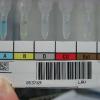Reputation Activity
-
 Dansket got a reaction from kate murphy in Manual Entry and 2nd tech review?
Dansket got a reaction from kate murphy in Manual Entry and 2nd tech review?
A small facility doing a lot of blood banking by generalists should seriously consider an automated testing platform. Automated testing eliminates a wide range of errors associated with specimen identification, test tube labeling/handling, results entry, results interpretation and transcription.
Our platform prints a report with results and results interpretation. We affix a barcoded sample label to the report (one patient per sheet of paper). The barcode on the report is scanned into the LIS result entry routine and results are transcribed. This system works 24/7/365 with a single individual wholly responsible for results entry. I have used this system successfully over the past 10 years, both in a 525 bed Level II trauma center (>10000 rbcs transfused annually) and a 100 bed (<50% occupancy) community hospital(<1100 rbcs transfused annually).
I believe that any strategy that relies on double-checking a process by multiple individuals will fail. If an individual cannot accurately transcribe results in the system described above, they should not be working in a transfusion service.
Blood bankers need to embrace automation in the 21st century and discard 20th century manual processes.
Whew!!, I feel so much better now. Thanks.
-
 Dansket got a reaction from ElinF in Manual Entry and 2nd tech review?
Dansket got a reaction from ElinF in Manual Entry and 2nd tech review?
A small facility doing a lot of blood banking by generalists should seriously consider an automated testing platform. Automated testing eliminates a wide range of errors associated with specimen identification, test tube labeling/handling, results entry, results interpretation and transcription.
Our platform prints a report with results and results interpretation. We affix a barcoded sample label to the report (one patient per sheet of paper). The barcode on the report is scanned into the LIS result entry routine and results are transcribed. This system works 24/7/365 with a single individual wholly responsible for results entry. I have used this system successfully over the past 10 years, both in a 525 bed Level II trauma center (>10000 rbcs transfused annually) and a 100 bed (<50% occupancy) community hospital(<1100 rbcs transfused annually).
I believe that any strategy that relies on double-checking a process by multiple individuals will fail. If an individual cannot accurately transcribe results in the system described above, they should not be working in a transfusion service.
Blood bankers need to embrace automation in the 21st century and discard 20th century manual processes.
Whew!!, I feel so much better now. Thanks.
-
 Dansket got a reaction from goodchild in Manual Entry and 2nd tech review?
Dansket got a reaction from goodchild in Manual Entry and 2nd tech review?
A small facility doing a lot of blood banking by generalists should seriously consider an automated testing platform. Automated testing eliminates a wide range of errors associated with specimen identification, test tube labeling/handling, results entry, results interpretation and transcription.
Our platform prints a report with results and results interpretation. We affix a barcoded sample label to the report (one patient per sheet of paper). The barcode on the report is scanned into the LIS result entry routine and results are transcribed. This system works 24/7/365 with a single individual wholly responsible for results entry. I have used this system successfully over the past 10 years, both in a 525 bed Level II trauma center (>10000 rbcs transfused annually) and a 100 bed (<50% occupancy) community hospital(<1100 rbcs transfused annually).
I believe that any strategy that relies on double-checking a process by multiple individuals will fail. If an individual cannot accurately transcribe results in the system described above, they should not be working in a transfusion service.
Blood bankers need to embrace automation in the 21st century and discard 20th century manual processes.
Whew!!, I feel so much better now. Thanks.
-
 Dansket got a reaction from Likewine99 in Manual Entry and 2nd tech review?
Dansket got a reaction from Likewine99 in Manual Entry and 2nd tech review?
A small facility doing a lot of blood banking by generalists should seriously consider an automated testing platform. Automated testing eliminates a wide range of errors associated with specimen identification, test tube labeling/handling, results entry, results interpretation and transcription.
Our platform prints a report with results and results interpretation. We affix a barcoded sample label to the report (one patient per sheet of paper). The barcode on the report is scanned into the LIS result entry routine and results are transcribed. This system works 24/7/365 with a single individual wholly responsible for results entry. I have used this system successfully over the past 10 years, both in a 525 bed Level II trauma center (>10000 rbcs transfused annually) and a 100 bed (<50% occupancy) community hospital(<1100 rbcs transfused annually).
I believe that any strategy that relies on double-checking a process by multiple individuals will fail. If an individual cannot accurately transcribe results in the system described above, they should not be working in a transfusion service.
Blood bankers need to embrace automation in the 21st century and discard 20th century manual processes.
Whew!!, I feel so much better now. Thanks.
-
 Dansket got a reaction from albaugh in Manual Entry and 2nd tech review?
Dansket got a reaction from albaugh in Manual Entry and 2nd tech review?
A small facility doing a lot of blood banking by generalists should seriously consider an automated testing platform. Automated testing eliminates a wide range of errors associated with specimen identification, test tube labeling/handling, results entry, results interpretation and transcription.
Our platform prints a report with results and results interpretation. We affix a barcoded sample label to the report (one patient per sheet of paper). The barcode on the report is scanned into the LIS result entry routine and results are transcribed. This system works 24/7/365 with a single individual wholly responsible for results entry. I have used this system successfully over the past 10 years, both in a 525 bed Level II trauma center (>10000 rbcs transfused annually) and a 100 bed (<50% occupancy) community hospital(<1100 rbcs transfused annually).
I believe that any strategy that relies on double-checking a process by multiple individuals will fail. If an individual cannot accurately transcribe results in the system described above, they should not be working in a transfusion service.
Blood bankers need to embrace automation in the 21st century and discard 20th century manual processes.
Whew!!, I feel so much better now. Thanks.
-
 Dansket got a reaction from seraph44 in Manual Entry and 2nd tech review?
Dansket got a reaction from seraph44 in Manual Entry and 2nd tech review?
Were these ABO reporting errors, transcription errors or testing errors? Are your current test results (anti-A, anti-B, anti-D, etc.) entered into a computer, written on a paper worksheet or both? Need more information from you to be helpful.
-
 Dansket got a reaction from John C. Staley in Manual Entry and 2nd tech review?
Dansket got a reaction from John C. Staley in Manual Entry and 2nd tech review?
A small facility doing a lot of blood banking by generalists should seriously consider an automated testing platform. Automated testing eliminates a wide range of errors associated with specimen identification, test tube labeling/handling, results entry, results interpretation and transcription.
Our platform prints a report with results and results interpretation. We affix a barcoded sample label to the report (one patient per sheet of paper). The barcode on the report is scanned into the LIS result entry routine and results are transcribed. This system works 24/7/365 with a single individual wholly responsible for results entry. I have used this system successfully over the past 10 years, both in a 525 bed Level II trauma center (>10000 rbcs transfused annually) and a 100 bed (<50% occupancy) community hospital(<1100 rbcs transfused annually).
I believe that any strategy that relies on double-checking a process by multiple individuals will fail. If an individual cannot accurately transcribe results in the system described above, they should not be working in a transfusion service.
Blood bankers need to embrace automation in the 21st century and discard 20th century manual processes.
Whew!!, I feel so much better now. Thanks.
-
 Dansket got a reaction from Maureen in Blood Bank Saline Problems
Dansket got a reaction from Maureen in Blood Bank Saline Problems
What brand/model of Cell Washer are you using? I would replace/clean/bleach all the tubing from the saline container to the dispense nozzles in the cell washer. I would clean/bleach all the nozzles in the washer.
-
 Dansket reacted to goodchild in Freaking out...current Neg ABSC...reported as Positive
Dansket reacted to goodchild in Freaking out...current Neg ABSC...reported as Positive
I'm with Donna on this one. You can't charge for something that isn't being done.
-
 Dansket reacted to Eagle Eye in Freaking out...current Neg ABSC...reported as Positive
Dansket reacted to Eagle Eye in Freaking out...current Neg ABSC...reported as Positive
I do not think you should never change antibody screen result negative to positive. Your test result was negative screen so it should be reported as such. by changing it to positive , you are actually falsifying the records.
Re: antibody in past? we do not worry about positive in the past and negative now as floor can view patient prior record in EMR and if they have a doubt they call blood bank regarding delay.
-
 Dansket got a reaction from MARINA in Still upgrading SOPs on rule in/rule out antibodies
Dansket got a reaction from MARINA in Still upgrading SOPs on rule in/rule out antibodies
No, we do not follow such a policy (it may be unique to your facility!).
To address this issue operationally, I use the AntigenPlus program. http://www.antigenplus.com/
This program standardizes the rule-out process (excluding antigens to which the patient may have antibody). This is only the first of the many steps required for antibody identification.
Everyone in my staff of generalists is required to use the program.
-
 Dansket got a reaction from EDibble in Antibody Screen At Delivery
Dansket got a reaction from EDibble in Antibody Screen At Delivery
As there is no bullet-proof system for determining whether anti-D detected at delivery is due to passive or active immunization, we discontinued antibody screens as part of our Postpartum Rh Immune Globlulin Protocol. Has the physician indicated what he would do if "the RHIG did not work"?
-
 Dansket reacted to kate murphy in Non-RBC transfusion reaction
Dansket reacted to kate murphy in Non-RBC transfusion reaction
I am a big fan of using standardization. Especially in this age of generalists.
That said, we do the exact same thing for every reaction workup - clerical check, post ABO/Rh, DAT, visual hemolysis inspection, other tests as indicated by reaction.
Less confusion for the techs - a reaction is a reaction.
-
 Dansket reacted to David Saikin in Non-RBC transfusion reaction
Dansket reacted to David Saikin in Non-RBC transfusion reaction
I agree with Kate - it is one thing if you have a dedicated blood bank staff on all shifts but when everyone is a generalist the more standardized the better.
-
 Dansket got a reaction from pdameron in Blood Bank computer modifications with no notice
Dansket got a reaction from pdameron in Blood Bank computer modifications with no notice
You have a right, without fear of retaliation, to contact your laboratory's accrediting agency(ies) regarding this issue.
-
 Dansket got a reaction from Maureen in ABO/RH
Dansket got a reaction from Maureen in ABO/RH
I would be surprised if this guru is currently responsible for the activities of an active transfusion service. It is easy to state, "Get it right the first time". I think the guru's logic is flawed in that it compares apples to oranges! A lab test result can vary from minute to minute, ABO blood types do not. Physicians can challenge a lab test result if it doesn't fit with their clinical assessment and request repeat testing or repeat specimen collection. Not so with a ABO blood type. How does this work when patients share identities and insurance cards?
I would also challenge the guru's logic regarding the inability of donor centers in the United States to guarantee that the blood container ABO/Rh label is correct.. Why can't they "get it right the first time"? Transfusion Services are required to confirm the correctness of the ABO container label, because the donor center cannot guarantee it is correct.
The electronic crossmatch is based on the logic, Determine the ABO/Rh (donor center) and then verify it (transfusion service). This logic works for both donor units and for patients, "Trust but verify".
-
 Dansket got a reaction from Sandy L in ABO/RH
Dansket got a reaction from Sandy L in ABO/RH
I would be surprised if this guru is currently responsible for the activities of an active transfusion service. It is easy to state, "Get it right the first time". I think the guru's logic is flawed in that it compares apples to oranges! A lab test result can vary from minute to minute, ABO blood types do not. Physicians can challenge a lab test result if it doesn't fit with their clinical assessment and request repeat testing or repeat specimen collection. Not so with a ABO blood type. How does this work when patients share identities and insurance cards?
I would also challenge the guru's logic regarding the inability of donor centers in the United States to guarantee that the blood container ABO/Rh label is correct.. Why can't they "get it right the first time"? Transfusion Services are required to confirm the correctness of the ABO container label, because the donor center cannot guarantee it is correct.
The electronic crossmatch is based on the logic, Determine the ABO/Rh (donor center) and then verify it (transfusion service). This logic works for both donor units and for patients, "Trust but verify".
-
 Dansket got a reaction from goodchild in ABO/RH
Dansket got a reaction from goodchild in ABO/RH
I would be surprised if this guru is currently responsible for the activities of an active transfusion service. It is easy to state, "Get it right the first time". I think the guru's logic is flawed in that it compares apples to oranges! A lab test result can vary from minute to minute, ABO blood types do not. Physicians can challenge a lab test result if it doesn't fit with their clinical assessment and request repeat testing or repeat specimen collection. Not so with a ABO blood type. How does this work when patients share identities and insurance cards?
I would also challenge the guru's logic regarding the inability of donor centers in the United States to guarantee that the blood container ABO/Rh label is correct.. Why can't they "get it right the first time"? Transfusion Services are required to confirm the correctness of the ABO container label, because the donor center cannot guarantee it is correct.
The electronic crossmatch is based on the logic, Determine the ABO/Rh (donor center) and then verify it (transfusion service). This logic works for both donor units and for patients, "Trust but verify".
-
 Dansket got a reaction from Sko681 in ABO/RH
Dansket got a reaction from Sko681 in ABO/RH
I would be surprised if this guru is currently responsible for the activities of an active transfusion service. It is easy to state, "Get it right the first time". I think the guru's logic is flawed in that it compares apples to oranges! A lab test result can vary from minute to minute, ABO blood types do not. Physicians can challenge a lab test result if it doesn't fit with their clinical assessment and request repeat testing or repeat specimen collection. Not so with a ABO blood type. How does this work when patients share identities and insurance cards?
I would also challenge the guru's logic regarding the inability of donor centers in the United States to guarantee that the blood container ABO/Rh label is correct.. Why can't they "get it right the first time"? Transfusion Services are required to confirm the correctness of the ABO container label, because the donor center cannot guarantee it is correct.
The electronic crossmatch is based on the logic, Determine the ABO/Rh (donor center) and then verify it (transfusion service). This logic works for both donor units and for patients, "Trust but verify".
-
 Dansket got a reaction from Sandy L in Checkcell (weak) vs. DAT/IAT and other reagents
Dansket got a reaction from Sandy L in Checkcell (weak) vs. DAT/IAT and other reagents
Don't understand how Check cell reactions can be graded as 1+, 2+, 3+ or 4+? Technically all Check cell reactions are "mixed-field". In an negative antibody screen tube (with reactive anti-antiglobulin reagent), there is one drop of unagglutinated antibody screen cells and one drop of agglutinated Check cells.
Back in the old days using paper worksheets, we used a check mark to indicate "macroscopic agglutination" observed after addition of check cells to a negative antiglobulin test.
-
 Dansket got a reaction from David Saikin in Checkcell (weak) vs. DAT/IAT and other reagents
Dansket got a reaction from David Saikin in Checkcell (weak) vs. DAT/IAT and other reagents
Don't understand how Check cell reactions can be graded as 1+, 2+, 3+ or 4+? Technically all Check cell reactions are "mixed-field". In an negative antibody screen tube (with reactive anti-antiglobulin reagent), there is one drop of unagglutinated antibody screen cells and one drop of agglutinated Check cells.
Back in the old days using paper worksheets, we used a check mark to indicate "macroscopic agglutination" observed after addition of check cells to a negative antiglobulin test.
-
 Dansket got a reaction from Likewine99 in Spun/unspun tube groups
Dansket got a reaction from Likewine99 in Spun/unspun tube groups
I would term this "institutional inertia".
Is this practice documented in a procedure manual? If so, what was the date of implementation?
Are you in a position to compile some data comparing immediate-spin tube test results with un-centrifuged tube test results?
-

-
 Dansket got a reaction from Malcolm Needs in ABO/RH
Dansket got a reaction from Malcolm Needs in ABO/RH
Retesting the same specimen by the same tech may detect testing errors but it will not detect specimen collection errors. It you want to detect WBIT, collecting a second blood sample would be more effective. -
 Dansket got a reaction from Sko681 in Back in the world.
Dansket got a reaction from Sko681 in Back in the world.
John...I hate tube testing. Have not done tube testing since the last century and could never go back!!











